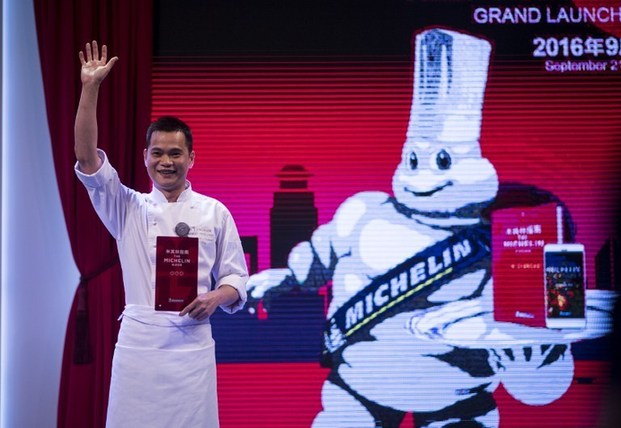Michelin food guide launched in city amid voices of discontent
 0 Comment(s)
0 Comment(s) Print
Print E-mail Shanghai Daily, September 22, 2016
E-mail Shanghai Daily, September 22, 2016

Michelin food guide launched its first edition on the Chinese mainland yesterday, awarding its highly-prized stars to top-tier restaurants, including a Cantonese establishment with just six tables, and in the process cooked up a storm among local gourmets.
T’ang Court, inside Langham Shanghai, in Xintiandi was awarded three Michelin stars and hailed as “exceptional cuisine, worth a special journey” in the Michelin Guide Shanghai 2017.
The guide awarded two stars to seven restaurants with more than half of them offering a variety of Chinese cuisines, including two stars for Canton 8 — a popular lunchtime spot catering to local families, Michelin said.
Another 18 restaurants were given one star.
In its first edition, Cantonese restaurants emerged the biggest winner, with only a few Shanghainese restaurants making the grade, triggering a debate among food connoisseurs for ignoring local flavors.
“The Michelin Guide announced its recommendation for the best restaurants in Shanghai today, but I think it does not cater to the taste of Shanghainese,” said Joey Ma, a local editor who has tried out half of the star-rated restaurants listed in the guide.
A food critic, Xu Qianlai said “most of Michelin Guide’s inspectors are from overseas or from Hong Kong and Macau. It is difficult for them to capture the essence of local delicacies.”
But Michael Ellis, Michelin Guide International Director, disputed that and said the team had an inspector from Shanghai, and it took them more than a year to come up with the final selection.
“You can agree or disagree with the result, but I think what you can not disregard is the fact that we have our own inspectors, our methods, and our criteria.”
He insisted that the number of Shanghainese restaurants covered in the guide still ranked the second among Chinese cuisine restaurants, and Canton 8, which has a set menu for 48 yuan (US$ 7), is also included in the two-starred restaurants — among the least expensive two-starred restaurants in the world.
“In this guide, you will find quite a few restaurants that are local and affordable,” he insisted.
The quality of ingredients, the chef’s personality as revealed through cuisine, the preparation and combination of flavors, value for money and the ability to produce excellent cooking with consistency over time and across the entire menu were the five criteria applied by the Michelin inspectors.
Restaurants that have won a star from the culinary bible have in the past built big businesses after being recognized, with Hong Kong’s Tim Ho Wan and Taiwan’s Din Tai Fung turning into international franchises.
Canton 8 can likely expect to see a similar surge in customers. On Tuesday night, before the release of the guide, the inexpensive two-story restaurant was filled with only around 20 diners feasting on crystal prawn dumplings and lobster porridge. Chef Jian Jieming of Canton 8 said he had “never dreamed” of making the list. He credited the fresh ingredients and “comfortable atmosphere” of the restaurant for its two stars.
In terms of the three-starred T’ang Court, Ellis said it was worth a special visit.
“In the cozy atmosphere of T’ang Court where only six tables are set, the talented and creative chef Justin Tan offers cuisine in which traditional Cantonese dishes rub shoulders with some very modern dishes,” said Ellis.
“Some specialities really amazed the palates of our inspectors.”
A native to Zhanjiang, Guangdong Province, Tan has been working as a chef since 1993. “I am nervous when I sit here, and the award is a surprising delight and great recognition for our team,” said Tan Shiye, or Justin Tan, Chinese Executive Chef of the restaurant.
Shanghai is the latest Asian city to feature in the guide following the launch of editions focusing on Hong Kong, Taipei and Singapore.
“What makes Shanghai particularly exciting is that the city is an economic and cultural crossroad, and its gastronomy is the result of a strong culinary heritage which makes the dining scene very exciting,” Ellis said.
“China has the most amazing gastronomic culture, and for historic reasons it has not been at the forefront of international gastronomy,” said Fuchsia Dunlop, a cook and food writer specializing in Chinese cuisine.
But she was not convinced Michelin’s approach of sending individual reviewers could truly identify the country’s best restaurants.
Chinese cuisine traditionally caters to groups, with family-style meals consisting of several shared dishes, she said.
“If you have one person going out to eat, it’s impossible for them to get a sense of a full, balanced Chinese meal,” she said.
“Even if you went 10 times, you wouldn’t get a sense of a meal with all the contrasts.”






Go to Forum >>0 Comment(s)